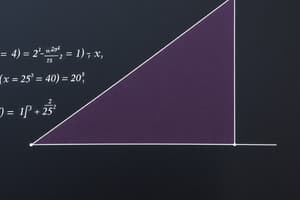Podcast
Questions and Answers
What is the vertex of the graph of $-5(x + 4)^2 - 5$?
What is the vertex of the graph of $-5(x + 4)^2 - 5$?
- (5, 9)
- (0, -15)
- (-4, -5) (correct)
- (-3, 4)
Identify the vertex of the parabola $F(x) = -3(x - 5)^2 + 9.
Identify the vertex of the parabola $F(x) = -3(x - 5)^2 + 9.
(5, 9)
Identify the vertex of the parabola $F(x) = 3x^2 + 18x + 31.$
Identify the vertex of the parabola $F(x) = 3x^2 + 18x + 31.$
(-3, 4)
Give the interval where the function $F(x) = (x + 5)^2 + 6$ increases.
Give the interval where the function $F(x) = (x + 5)^2 + 6$ increases.
Find the y-intercepts and any x-intercepts of the equation $y = x^2 - 2x - 15.$
Find the y-intercepts and any x-intercepts of the equation $y = x^2 - 2x - 15.$
Solve the quadratic inequality by graphing $x^2 - 4x + 3 \geq 0.$
Solve the quadratic inequality by graphing $x^2 - 4x + 3 \geq 0.$
Factor the polynomial $x^3 + 5x^2 - 48x - 252$ completely given that $x - 7$ is a factor.
Factor the polynomial $x^3 + 5x^2 - 48x - 252$ completely given that $x - 7$ is a factor.
State the degree of the polynomial equation $-6x^2(x - 7)(x + 3)^3 = 0$.
State the degree of the polynomial equation $-6x^2(x - 7)(x + 3)^3 = 0$.
Find a polynomial equation with real coefficients that has the given roots: 2, -8, 3 + 5i.
Find a polynomial equation with real coefficients that has the given roots: 2, -8, 3 + 5i.
Use the rational zero theorem, Descartes's rule of signs, and the theorem on bounds as aids in finding all real and imaginary roots to the equation $x^4 + 15x^3 + 49x^2 - 15x - 50 = 0$.
Use the rational zero theorem, Descartes's rule of signs, and the theorem on bounds as aids in finding all real and imaginary roots to the equation $x^4 + 15x^3 + 49x^2 - 15x - 50 = 0$.
Find all real solutions to the equation $\sqrt{x + 13} = x - 7$.
Find all real solutions to the equation $\sqrt{x + 13} = x - 7$.
Find all real and imaginary solutions to the equation $(2m - 1)^2 - 4(2m - 1) - 21 = 0$.
Find all real and imaginary solutions to the equation $(2m - 1)^2 - 4(2m - 1) - 21 = 0$.
Solve the absolute value equation $|x^2 - 10| = 4$.
Solve the absolute value equation $|x^2 - 10| = 4$.
Describe the behavior of the function's graph at its x-intercepts for $f(x) = (x - 2)^2(x + 6)$.
Describe the behavior of the function's graph at its x-intercepts for $f(x) = (x - 2)^2(x + 6)$.
Use the leading coefficient test to determine whether $y \to \infty$ or $y \to -\infty$ as $x \to \infty$ for $y = -x^5 - 2x^3 - 7x + 4$.
Use the leading coefficient test to determine whether $y \to \infty$ or $y \to -\infty$ as $x \to \infty$ for $y = -x^5 - 2x^3 - 7x + 4$.
Use the leading coefficient test to determine whether $y \to \infty$ or $y \to -\infty$ as $x \to -\infty$ for $y = 2x^4 + 2x^2 + x - 5$.
Use the leading coefficient test to determine whether $y \to \infty$ or $y \to -\infty$ as $x \to -\infty$ for $y = 2x^4 + 2x^2 + x - 5$.
Sketch the graph of the polynomial function $f(x) = -2x(x - 2)(x + 1)$.
Sketch the graph of the polynomial function $f(x) = -2x(x - 2)(x + 1)$.
Sketch the graph of the polynomial function $F(x) = (3x + 2)(x - 2)^2$.
Sketch the graph of the polynomial function $F(x) = (3x + 2)(x - 2)^2$.
State the domain of the rational function $F(x) = \frac{16}{14 - x}$.
State the domain of the rational function $F(x) = \frac{16}{14 - x}$.
Determine the domain and the equations of the asymptotes for the graph of the rational function given x-intercepts: (3, 0) and y-intercept: (0, 4).
Determine the domain and the equations of the asymptotes for the graph of the rational function given x-intercepts: (3, 0) and y-intercept: (0, 4).
For the function $\frac{(x - 4)(x + 8)}{x^2 - 1}$, find all vertical asymptotes (if any).
For the function $\frac{(x - 4)(x + 8)}{x^2 - 1}$, find all vertical asymptotes (if any).
For the function $\frac{6x^2 - 5x - 3}{5x^2 - 9x + 4}$, find all horizontal asymptotes (if any).
For the function $\frac{6x^2 - 5x - 3}{5x^2 - 9x + 4}$, find all horizontal asymptotes (if any).
Sketch the graph of the function $f(x) = \frac{2x + 1}{x}$. What are the vertical and horizontal asymptotes?
Sketch the graph of the function $f(x) = \frac{2x + 1}{x}$. What are the vertical and horizontal asymptotes?
Flashcards
Vertex of a Parabola
Vertex of a Parabola
The highest or lowest point on a parabola.
Negative Leading Coefficient
Negative Leading Coefficient
The parabola opens downward.
Y-intercept
Y-intercept
The point where the graph crosses the y-axis.
X-intercepts
X-intercepts
Signup and view all the flashcards
Quadratic Inequality Solution
Quadratic Inequality Solution
Signup and view all the flashcards
Factoring Polynomials
Factoring Polynomials
Signup and view all the flashcards
Degree of a Polynomial
Degree of a Polynomial
Signup and view all the flashcards
Polynomial Root
Polynomial Root
Signup and view all the flashcards
Complex Root
Complex Root
Signup and view all the flashcards
Solving Radical Equations
Solving Radical Equations
Signup and view all the flashcards
Extraneous Solution
Extraneous Solution
Signup and view all the flashcards
Solving Equations by Substitution
Solving Equations by Substitution
Signup and view all the flashcards
Absolute Value
Absolute Value
Signup and view all the flashcards
Touching at x-intercept
Touching at x-intercept
Signup and view all the flashcards
Crossing at x-intercept
Crossing at x-intercept
Signup and view all the flashcards
Leading Coefficient Test
Leading Coefficient Test
Signup and view all the flashcards
End Behavior (x→∞, y→-∞)
End Behavior (x→∞, y→-∞)
Signup and view all the flashcards
End Behavior (x→-∞, y→∞)
End Behavior (x→-∞, y→∞)
Signup and view all the flashcards
Graph Sketching
Graph Sketching
Signup and view all the flashcards
Rational Function
Rational Function
Signup and view all the flashcards
Domain of a Function
Domain of a Function
Signup and view all the flashcards
Asymptote
Asymptote
Signup and view all the flashcards
Vertical Asymptote
Vertical Asymptote
Signup and view all the flashcards
Horizontal Asymptote
Horizontal Asymptote
Signup and view all the flashcards
Study Notes
Quadratic Functions
- The graph of ( -5(x+4)^2-5 ) opens downward with a vertex at (-4, -5).
- The vertex of the parabola ( F(x) = -3(x-5)^2 + 9 ) is located at (5, 9).
- For ( F(x) = 3x^2 + 18x + 31 ), the vertex is (-3, 4).
Function Behavior
- The function ( F(x) = (x+5)^2 + 6 ) increases on the interval [-5, infinity).
- The y-intercept of ( y = x^2 - 2x - 15 ) is (0, -15) and the x-intercepts are (5, 0) and (-3, 0).
- The quadratic inequality ( x^2 - 4x + 3 \geq 0 ) has solutions in the intervals (-∞, 1] and [3, ∞).
Polynomial Operations
- Factoring the polynomial ( x^3 + 5x^2 - 48x - 252 ) given the factor ( x - 7 ) results in ( (x-7)(x+6)^2 ).
- The degree of the polynomial equation ( -6x^2(x-7)(x+3)^3 = 0 ) is 6.
Polynomial Roots
- A polynomial with real coefficients having roots 2, -8, and ( 3+5i ) is expressed as ( (x-2)(x+8)(x-3-5i)(x-3+5i) ).
Solving Equations
- The real solution for ( \sqrt{x} + 13 = x - 7 ) is ( x = 12 ).
- The equation ( (2m-1)^2 - 4(2m-1) - 21 = 0 ) has real and imaginary solutions ( m = -2 ) and ( m = 3 ).
Absolute Value and Intercepts
- The absolute value equation ( |x^2 - 10| = 4 ) yields solutions of ( -\sqrt{6}, \sqrt{6}, -\sqrt{14}, \sqrt{14} ).
- The function ( f(x) = (x-2)^2(x+6) \ exhibits behavior at x-intercepts: (2, 0) touches and (-6, 0) crosses.
Leading Coefficient Test
- For ( y = -x^5 - 2x^3 - 7x + 4 ), as ( x \to \infty ), ( y \to -\infty ).
- The function ( 2x^4 + 2x^2 + x - 5 ) has ( y \to \infty ) as ( x \to -\infty ).
Graph Sketching
- Sketching ( f(x) = -2x(x-2)(x+1) \ results in crossing points at (0,0), (2,0), and (-1,0).
- The graph of ( F(x) = (3x + 2)(x - 2)^2 \ shows crossing at ((-2/3, 0)) and touching at (2, 0).
Rational Functions
- The domain of the rational function ( F(x) = \frac{16}{14-x} ) is (-∞, 14) ∪ (14, ∞).
- For the rational function with intercepts (3, 0) and (0, 4), the domain is (-∞, 3) ∪ (3, ∞), with asymptotes at ( x=3 ) and ( y=4 ).
- The function ( \frac{(x-4)(x+8)}{x^2-1} \ has vertical asymptotes at ( x = 1 ) and ( x = -1 ).
- A horizontal asymptote at ( y = \frac{6}{5} \ is present for ( \frac{6x^2 - 5x - 3}{5x^2 - 9x + 4} ).
Additional Graph Features
- The function ( f(x) = \frac{2x + 1}{x} ) indicates a vertical asymptote at ( x = 0 ) and a horizontal asymptote at ( y = 2 ).
Studying That Suits You
Use AI to generate personalized quizzes and flashcards to suit your learning preferences.




